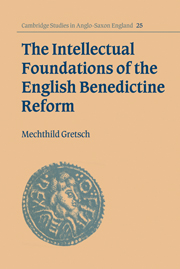Book contents
- Frontmatter
- Contents
- Preface
- List of abbreviations
- 1 Introduction
- 2 Psalters and psalter glosses in Anglo-Saxon England
- 3 The vocabulary of the Royal Psalter
- 4 The Royal Psalter and the Rule: lexical and stylistic links
- 5 The Aldhelm glosses
- 6 Word usage in the Royal Psalter, the Rule and the Aldhelm glosses
- 7 Æthelwold and the Old English Rule
- 8 Æthelwold and the Royal Psalter
- 9 Æthelwold and the Aldhelm glosses
- 10 French and German loan influence
- 11 Conclusion
- Appendix I Æthelwold's life and career
- Appendix II The Royal Psalter at Canterbury
- Appendix III The Gernrode fragments of an Old Saxon psalm commentary
- Bibliography
- Index of Old English words
- Index of Latin words
- General index
9 - Æthelwold and the Aldhelm glosses
Published online by Cambridge University Press: 01 October 2009
- Frontmatter
- Contents
- Preface
- List of abbreviations
- 1 Introduction
- 2 Psalters and psalter glosses in Anglo-Saxon England
- 3 The vocabulary of the Royal Psalter
- 4 The Royal Psalter and the Rule: lexical and stylistic links
- 5 The Aldhelm glosses
- 6 Word usage in the Royal Psalter, the Rule and the Aldhelm glosses
- 7 Æthelwold and the Old English Rule
- 8 Æthelwold and the Royal Psalter
- 9 Æthelwold and the Aldhelm glosses
- 10 French and German loan influence
- 11 Conclusion
- Appendix I Æthelwold's life and career
- Appendix II The Royal Psalter at Canterbury
- Appendix III The Gernrode fragments of an Old Saxon psalm commentary
- Bibliography
- Index of Old English words
- Index of Latin words
- General index
Summary
In our search for non-linguistic evidence which could confirm the suspicion (grounded on lexical and stylistic considerations) that Æthelwold played a leading part in vernacular Aldhelm glossing, we must first address a question which thus far has not been satisfactorily answered, namely in what historical and intellectual context the origins of the late Anglo-Saxon fascination with Aldhelm and the hermeneutic style may be sought.
KING ÆTHELSTAN'S COURT
The resuscitation of the hermeneutic style first becomes tangible during the reign of Æthelstan (924–39), the first monarch to rule over a unified England and the first to extend the territory of a southern king beyond the Humber. From Æthelstan's charters and his coinage, where, from 927 onwards (after the annexation of Northumbria), he is referred to by the royal style rex totius Britanniae, or by some similar formula, it is abundantly clear that the king and his entourage were well aware and proud of what had been achieved. It may not be out of question, therefore, to suspect that, from its beginnings, there was a strong political and national component in the tenth-century revival of the hermeneutic style. After all, Aldhelm (c. 640–709×710), the principal source of inspiration for tenth-century Anglo-Latinity, was an author who had been held in great esteem and had been much imitated by Anglo-Saxon (and continental) writers before the production of Latin literature seems to have come to a complete standstill in England in the wake of the Viking depredations in the ninth century.
- Type
- Chapter
- Information
- The Intellectual Foundations of the English Benedictine Reform , pp. 332 - 383Publisher: Cambridge University PressPrint publication year: 1999

